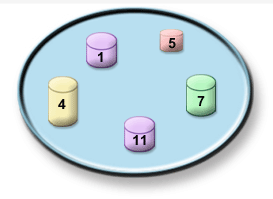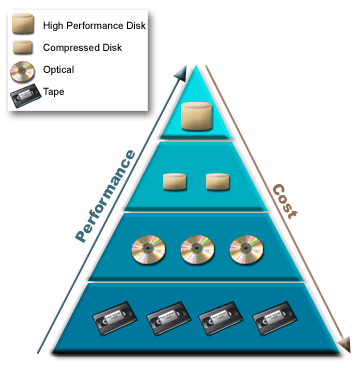This topic describes how disk storage on the iSeries™ works and describes how it can be configured and used for different storage purposes.
Disk storage is the storage that is usually internal to your iSeries server; however, it can also be attached externally to it. You can group your disk drives into logical subsets called disk pools (also known as auxiliary storage pools or ASPs). One reason to do this is to provide a level of protection for your data. If one disk unit fails, you only have to recover the data stored in the disk pool that the failed disk unit was a part of.
Disk pools also enable you to set disk space aside for a particular purpose, application, or data type. For example, you may create a disk pool for backups done to save files. You can then move these save files to tape or other media when it is convenient for you. The following diagram shows a disk pool that is composed of disk units 1, 4, 5, 7, and 11.

For detailed information about disk pools, disk pool types, and examples of how to use disk pools for different purposes, see Disk pools. For information about how to configure disk units and disk pools, see Manage disk pools.
Independent disk pools are disk pools that can be brought online or taken offline without any dependencies on the rest of the storage on a system. This is possible because all of the necessary system information associated with the independent disk pool is contained within the independent disk pool. Independent disk pools offer a number of availability and performance advantages in both single and multiple system environments. For detailed information, see Using independent disk pools.
Besides disk pools, there are a few other ways to protect your disk units and the data on them. Mirrored protection protects your data by keeping a copy of the data on two separate disk units. When a disk-related component fails, the system may continue to operate without interruption by using the mirrored copy of the data until the failed component is repaired. Device parity protection is a hardware function that enables your server to reconstruct data in the event of a disk failure. It is important to remember that these disk protection methods are not a guarantee against failure or data loss. You still need to have a good backup and recovery strategy in place in order to truly protect your data. For detailed information about the disk protection methods described here, see Plan for disk protection.
Compared to tape or optical, disk is a more expensive storage option. However, the data on disk is more quickly accessible than on tape or optical. It is important to balance the cost of storing data on disk with the speed and convenience with which you can access that data. For example, if you have older data that you access infrequently, you may want to consider storing it on tape or optical, rather than on disk. Likewise, current information that you access frequently might be worth the cost of disk storage because you can access it quickly. This type of storage strategy is called hierarchical storage management. The following diagram shows the different layers of hierarchical storage management:

It is not always the same data that resides in the high performance storage components. Data is moved among the different layers according to the current system needs. The key to successful and seamless hierarchical storage management lies in the management and distribution of data across the different layers. For detailed information, see Hierarchical Storage Management.